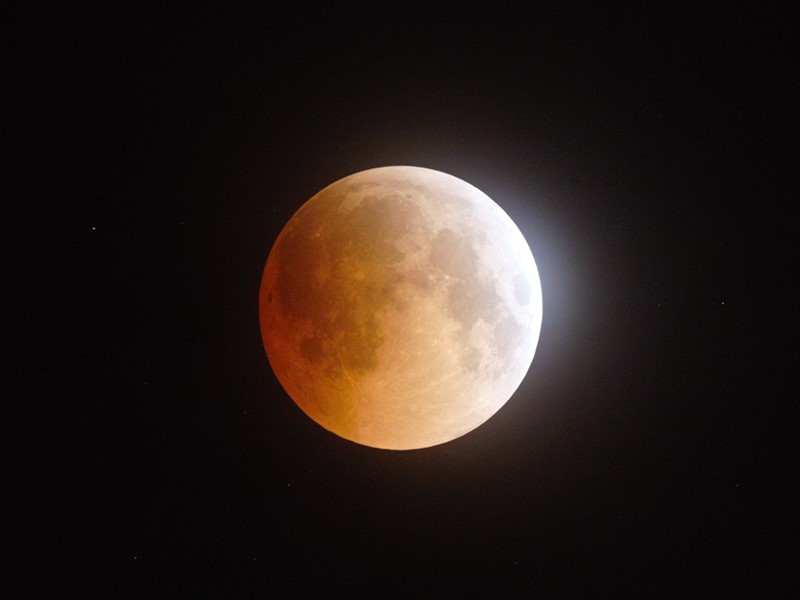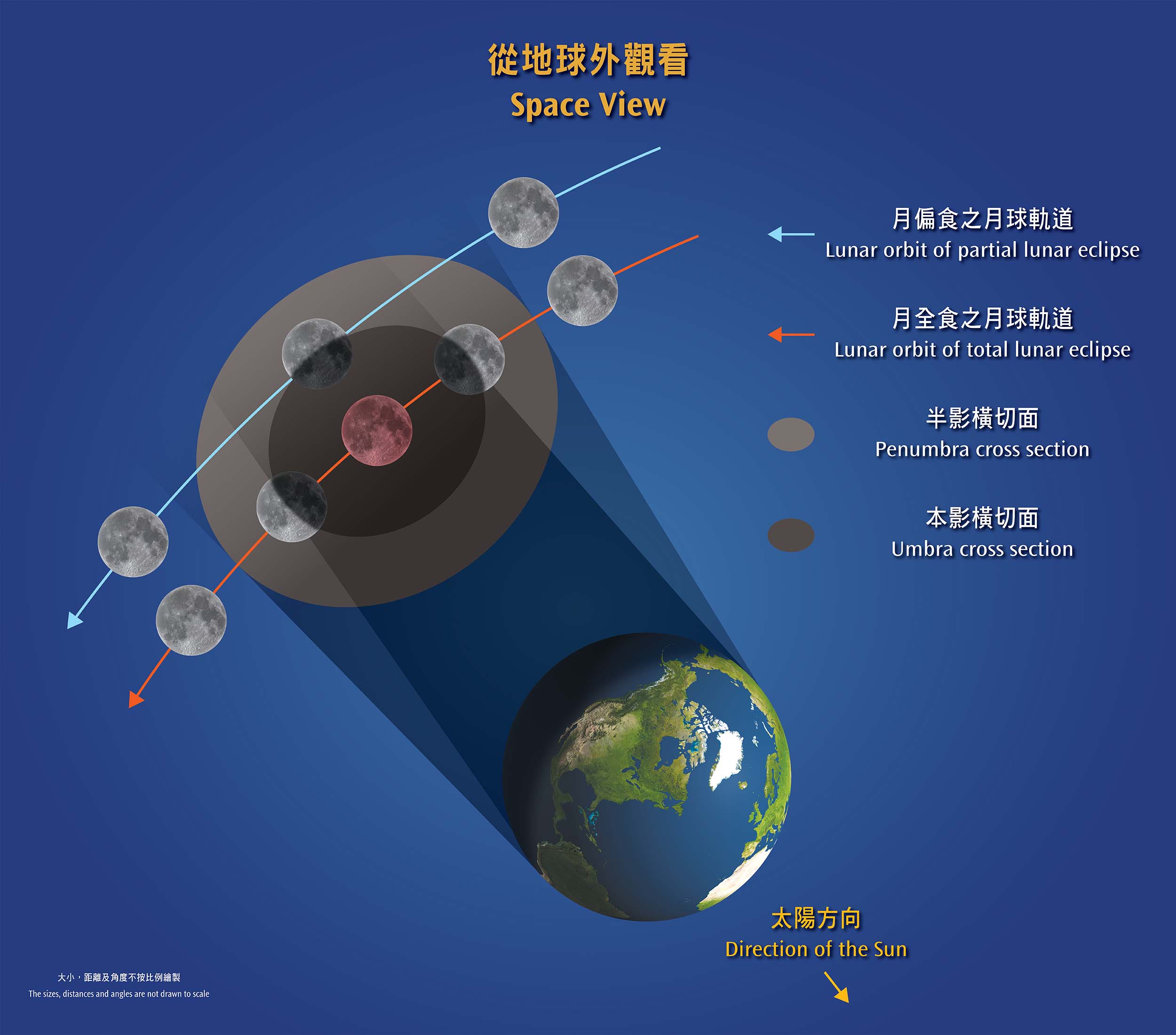 Web Content Display
Web Content Display

Lunar Eclipse
Tab Menu
 Web Content Display
Web Content Display

With respect to the Earth, the Moon orbits once about every 29 days. When the moon moves into the shadow of the Earth, the sunlight that originally shines on the surface of the moon will be blocked gradually, resulting in a lunar eclipse.
Since the shadow is always in the opposite direction to the Sun, a lunar eclipse occurs only when the Moon comes in direct alignment with the Sun and the Earth. Depending on how the Moon interacts with the Earth's shadow, lunar eclipses can be divided into three types, namely the total lunar eclipse, partial lunar eclipse and penumbral lunar eclipse. When the Moon enters the Earth's penumbra, the amount of sunlight shined on the lunar surface reduces, therefore the brightness of the Moon decreases. However, if the moon only passes through the inner edge of the Earth's penumbra, the brightness of the lunar surface will only reduce by a tiny amount. This is why penumbral lunar eclipses are sometimes unnoticeable. When the moon enters the Earth's umbra, part of the lunar surface disappears, resulting in a partial lunar eclipse. Finally, a total lunar eclipse happens when the Moon enters the Earth's umbra completely.
A lunar eclipse can only occur around the 15th of a lunar month where the Sun and the Moon are about 180° apart from each other. Since the orbits of the sun and the moon in the sky (called the ecliptic and the Moon's path respectively) are not on the same plane but intersect at an angle of about 5 degrees, lunar eclipses do not occur every month. Only when the Sun and the Moon are close enough to the intersection of the two paths (known as lunar nodes), the Moon is able to enter the Earth's shadow to cause a lunar eclipse.
During a total lunar eclipse, we can still see a reddish Moon even though it is completely covered by the Earth's umbra. The reason behind this is that there are still some red lights from the Sun remaining in the Earth's umbra. When sunlight passes through the Earth's atmosphere, most of the blue lights are scattered by the air as the wavelengths are shorter (hence the sky is blue). In contrast, the wavelengths of red lights are longer, so they can penetrate the atmosphere and are partially refracted to the Earth's umbra to reach the Moon during a total lunar eclipse. Interestingly, the colour and brightness of these red lights can reflect the quality of the Earth's atmosphere. If a large volcanic eruption occurred before a total lunar eclipse, the thick ash in the atmosphere would weaken these red lights, making it difficult to see the Moon during a total lunar eclipse.
 Web Content Display
Web Content Display

- Moon enters penumbra: Instant of first contact between the Moon and the Earth's penumbra. The edge of the lunar surface starts dimming, but it is hard to distinguish the difference at the beginning.
- Moon enters umbra: Instant of first contact between the Moon and the Earth's umbra. The edge of the lunar surface starts disappearing. The Moon no longer appears round.
- Total eclipse begins: The Moon enters the Earth's umbra completely. The white moonlight vanishes. The Moon appears red.
- The greatest eclipse: The middle phase of a total lunar eclipse when the centre of the disc of the moon is the closest to the centre of the Earth's shadow.
- Total eclipse ends: The Moon leaves the Earth's umbra completely. The moonlight reappears at the edge of the lunar surface.
- Moon leaves umbra: Instant of last contact between the Moon and the Earth's umbra. The moon resumes to a round shape.
- Moon leaves penumbra: Instant of last contact between the Moon and the Earth's penumbra. The Moon resumes to its full brightness. It marks the end of the lunar eclipse.
 Web Content Display
Web Content Display
| Date1 | Type | Hong Kong | Hong Kong Time2 | Mag.3 | Moonrise | Moonset |
|---|---|---|---|---|---|---|
| 26.05.2021 | Total | Eclipse at Moonrise | 5:44pm - 8:52pm | 1.016 | 26.05 6:56pm | 27.05 6:08am |
| 19.11.2021 | Partial | Eclipse at Moonrise | 3:18pm - 6:47pm | 0.979 | 19.11 5:38pm | 20.11 7:12am |
| 16.05.2022 | Total | Invisible | 10:27am - 13:55pm | 1.420 | 16.05 7:12pm | 16.05 5:33am |
| 08.11.2022 | Total | Eclipse at Moonrise | 5:08pm - 8:49pm | 1.364 | 08.11 5:37pm | 09.11 7:02am |
| 05.05.2023 | Penumbral | Visible | 11:12pm - 3:33am | 0.989 | 05.05 6:32pm | 06.05 5:56am |
| 29.10.2023 | Partial | Visible | 03:34am - 4:53am | 0.127 | 28.10 5:25pm | 29.10 6:34am |
| 25.03.2024 | Penumbral | Invisible | 12:51pm - 5:34pm | 0.982 | 25.03 6:40pm | 25.03 6:18am |
| 18.09.2024 | Partial | Invisible | 10:11am - 11:16am | 0.091 | 18.09 6:37pm | 18.09 6:02am |
| 14.03.2025 | Total | Invisible | 1:09pm - 4:48pm | 1.183 | 14.03 6:36pm | 14.03 6:27am |
| 08.09.2025 | Total | Visible | 0:27am - 3:57am | 1.362 | 07.09 6:21pm | 08.09 6:21am |
| 03.03.2026 | Total | Eclipse at Moonrise | 5:49pm - 9:18pm | 1.156 | 03.03 6:22pm | 04.03 7:00am |
| 28.08.2026 | Partial | Invisible | 10:33am - 1:52pm | 0.935 | 28.08 6:49pm | 28.08 5:54am |
| 21.02.2027 | Penumbral | Eclipse at Moonset | 5:10am - 9:15am | 0.952 | 20.02 5:45pm | 21.02 6:50am |
| 18.07.2027 | Penumbral | Visible | 11:37pm - 12:29am | 0.027 | 18.07 7:02pm | 19.07 6:05am |
| 17.08.2027 | Penumbral | Invisible | 1:21pm - 5:06pm | 0.546 | 17.08 6:51pm | 18.08 6:36am |
| 12.01.2028 | Partial | Invisible | 11:43am - 12:42pm | 0.072 | 12.01 6:10pm | 12.01 7:00am |
| 07.07.2028 | Partial | Visible | 1:08am - 3:31am | 0.394 | 06.07 6:56pm | 07.07 5:56am |
| 31.12.2028 | Total | Visible | 11:07pm - 2:37am | 1.252 | 31.12 5:29pm | 01.01 7:20am |
| 26.06.2029 | Total | Invisible | 9:32am - 1:12pm | 1.849 | 26.06 7:25pm | 26.06 5:30am |
| 21.12.2029 | Total | Eclipse at Moonset | 4:55am - 8:29am | 1.122 | 20.12 5:13pm | 21.12 7:02am |
| 16.06.2030 | Partial | Visible | 1:20am - 03:46am | 0.508 | 15.06 6:44pm | 16.06 5:52am |
| 10.12.2030 | Penumbral | Eclipse at Moonset | 4:05am - 8:50am | 0.968 | 09.12 5:12pm | 10.12 6:54am |
1 The date showed in the table is the time for the "Moon enters umbra" or the "Moon enters penumbra".
2 For Total / Patial lunar eclipse, the time period is for the "Moon enters umbra" to "Moon leaves embra". For Penumbral lunar eclipse, the time period is for the "Moon enters penumbra" to "Moon leaves penumbra".
3 For Penumbral lunar eclipse, Magnitude is equal to Penumbral Magnitude.
